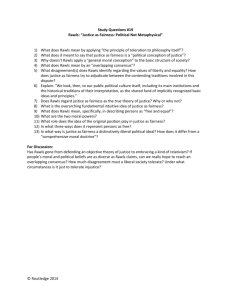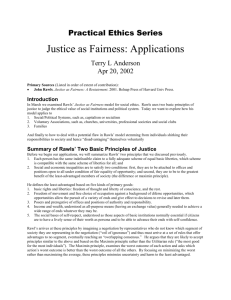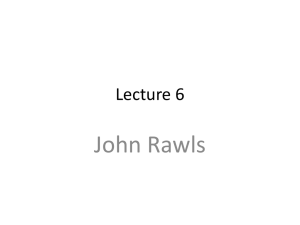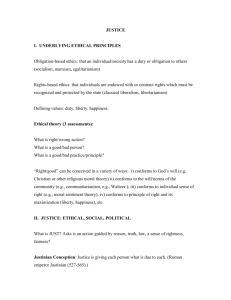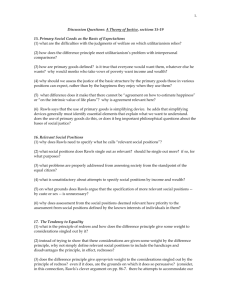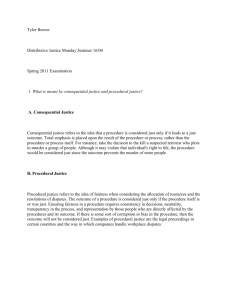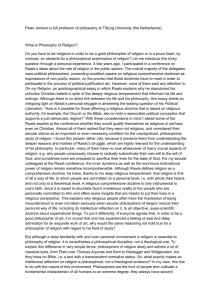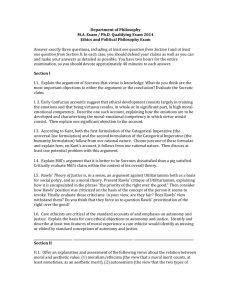Rawl`s Social Contract: Justice as Fairness
advertisement
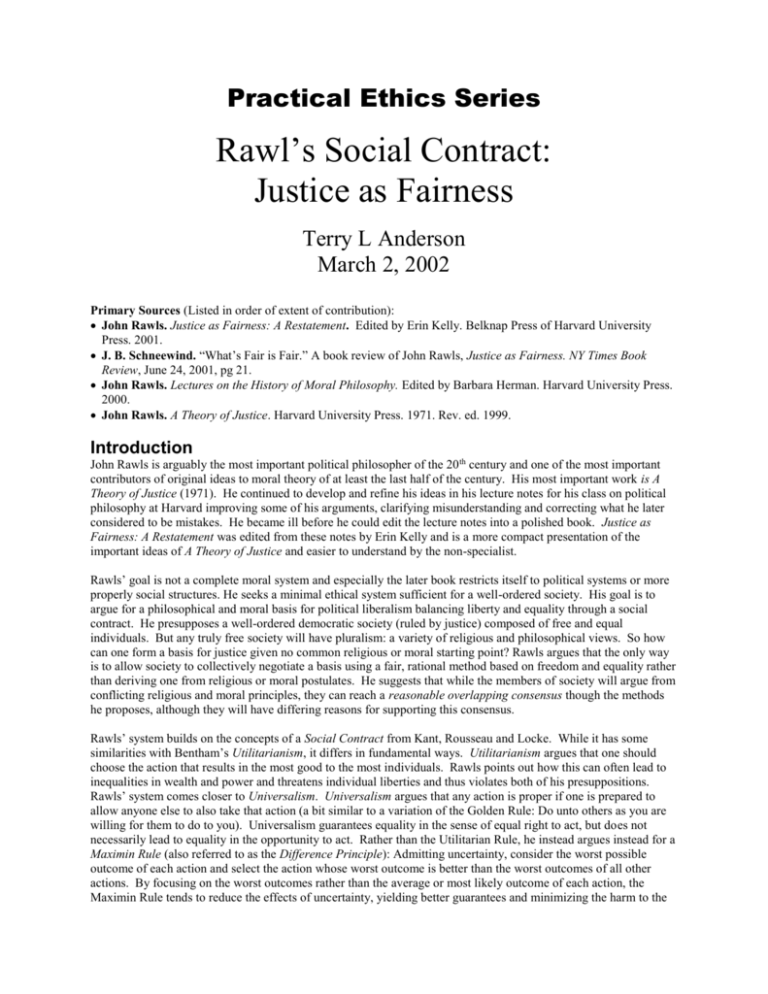
Practical Ethics Series Rawl’s Social Contract: Justice as Fairness Terry L Anderson March 2, 2002 Primary Sources (Listed in order of extent of contribution): John Rawls. Justice as Fairness: A Restatement. Edited by Erin Kelly. Belknap Press of Harvard University Press. 2001. J. B. Schneewind. “What’s Fair is Fair.” A book review of John Rawls, Justice as Fairness. NY Times Book Review, June 24, 2001, pg 21. John Rawls. Lectures on the History of Moral Philosophy. Edited by Barbara Herman. Harvard University Press. 2000. John Rawls. A Theory of Justice. Harvard University Press. 1971. Rev. ed. 1999. Introduction John Rawls is arguably the most important political philosopher of the 20 th century and one of the most important contributors of original ideas to moral theory of at least the last half of the century. His most important work is A Theory of Justice (1971). He continued to develop and refine his ideas in his lecture notes for his class on political philosophy at Harvard improving some of his arguments, clarifying misunderstanding and correcting what he later considered to be mistakes. He became ill before he could edit the lecture notes into a polished book. Justice as Fairness: A Restatement was edited from these notes by Erin Kelly and is a more compact presentation of the important ideas of A Theory of Justice and easier to understand by the non-specialist. Rawls’ goal is not a complete moral system and especially the later book restricts itself to political systems or more properly social structures. He seeks a minimal ethical system sufficient for a well-ordered society. His goal is to argue for a philosophical and moral basis for political liberalism balancing liberty and equality through a social contract. He presupposes a well-ordered democratic society (ruled by justice) composed of free and equal individuals. But any truly free society will have pluralism: a variety of religious and philosophical views. So how can one form a basis for justice given no common religious or moral starting point? Rawls argues that the only way is to allow society to collectively negotiate a basis using a fair, rational method based on freedom and equality rather than deriving one from religious or moral postulates. He suggests that while the members of society will argue from conflicting religious and moral principles, they can reach a reasonable overlapping consensus though the methods he proposes, although they will have differing reasons for supporting this consensus. Rawls’ system builds on the concepts of a Social Contract from Kant, Rousseau and Locke. While it has some similarities with Bentham’s Utilitarianism, it differs in fundamental ways. Utilitarianism argues that one should choose the action that results in the most good to the most individuals. Rawls points out how this can often lead to inequalities in wealth and power and threatens individual liberties and thus violates both of his presuppositions. Rawls’ system comes closer to Universalism. Universalism argues that any action is proper if one is prepared to allow anyone else to also take that action (a bit similar to a variation of the Golden Rule: Do unto others as you are willing for them to do to you). Universalism guarantees equality in the sense of equal right to act, but does not necessarily lead to equality in the opportunity to act. Rather than the Utilitarian Rule, he instead argues instead for a Maximin Rule (also referred to as the Difference Principle): Admitting uncertainty, consider the worst possible outcome of each action and select the action whose worst outcome is better than the worst outcomes of all other actions. By focusing on the worst outcomes rather than the average or most likely outcome of each action, the Maximin Rule tends to reduce the effects of uncertainty, yielding better guarantees and minimizing the harm to the -2least advantaged. We will see that this is related a more general rule, intended to increase equality and minimize differences between the various extremes in society. My intention this week is to give an overview of Rawls’ concepts and discuss them in general and then in a future session we will apply it to specific issues in society to see what conclusions it suggests. Rawls believes that in the years since first publication (1971) Western societies and especially the U.S. has moved further from his model rather than toward it, but he still argues that if followed, it would lead to a fairer and more stable society. He differs from utopian theorists in that the overlapping consensus will not be a unified, totally consistent principle and so the resulting society is fair and free but not a utopia. Original Position and the Veil of Ignorance Critical to understanding Rawls’ system is understanding the method he suggests for reaching overlapping consensus. He calls this the Original Position. Members of society reach a social contract or set of principles to guide behavior through a negotiation. This is not a real negotiation of real individuals, but an idealized negotiation where we assume that each individual thinks and negotiates rationally and is aware of social theory and human psychology and so can realistically assess the impact of various proposals. We must negotiate under certain conditions. We must assume free and equal persons and must not permit some to have unfair bargaining advantages over others. Threats of force and coercion, deception and fraud must be ruled out. But each individual will still be influenced by self-advantage and argue for principles that will give him or her and those like him or her more freedom or goods than others. In a simply democratic negotiation, the majority will still choose principles disadvantageous to the minority. So how do we find a system for negotiating an agreement that is fair to all. And so, Rawls introduces the Veil of Ignorance. This supposes that each participant represents, not himself or herself, but some unknown segment of society. They are not allowed to know the social positions or particular comprehensive doctrines of the persons they represent. They do not know the persons’ race and ethnic group, sex or various native endowments such as strength or intelligence. He expresses these limits on information figuratively by saying the parties are behind a veil of ignorance. [It is not clear to me, how one insures that the negotiator is really representing this veiled party rather than himself or herself during the negotiation, but we will have to assume this ideal. Perhaps we add the condition that after the representative has negotiated for the veiled persons’ they are able to accept or reject the settlement.] In addition, Rawls imposes some restrictions on the kind of arguments that can be used to justify a position. The result of the negotiation is a set of rules to order society. But another requirement is that they must also give a public justification for the rules. This idea is introduced to encourage a unity to the set of rules. A well-ordered society requires a public perception of justice even if the public justification differs from the individual reasons to support it based on differing religious, moral or philosophical bases. Rawls argues that a likely outcome of this process is a set of principles incorporating justice as fairness. He presents two basic principles of justice: 1. 2. Each person has the same indefeasible claim to a fully adequate scheme of equal basic liberties, which scheme is compatible with the same scheme of liberties for all; and Social and economic inequalities are to satisfy two conditions: first, they are to be attached to offices and positions open to all under conditions of fair equality of opportunity; and second, they are to be to the greatest benefit of the least-advantaged members of society (the difference or maximin principle). He defines the least-advantaged based on five kinds of primary goods: 1. 2. 3. 4. 5. basic rights and liberties: freedom of thought and liberty of conscience, and the rest. Freedom of movement and free choice of occupation against a background of diferse opportunities, which opportunities allow the pursuit of a variety of ends and give effect to decisions to revise and later them. Posers and prerogative of offices and positions of authority and responsibility. Income and wealth, understood as all-purpose means (having an exchange value) generally needed to achieve a wide range of ends whatever they may be. The social bases of self-respect, understood as those aspects of basic institutions normally essential if citizens are to have a lively sense of their worth as persona and to be able to advance their ends with self-confidence. -3- If the overlapping consensus leads to justice as fairness, then one of the primary tasks will be to assign “indexes” (values) to each of these goods so that totals can identify the least-advantaged segments of society. The second of the two principles means that alternative social rules must be compared by seeing how well of the least advantaged are under each alternative and then the alternative under which the least-advantaged are better off than under any other alternative must be selected. We can see that this is similar to the Utilitarian Principle except that the Maximin Rule is used rather the Utilitarian Rule to select the alternative. Rawls admits that in real societies given wide variation in comprehensive views there is no guarantee that a principle like Justice as Fairness will result from overlapping consensus but he argues why it is likely. He also discusses how Justice as Fairness will lead to political systems such as a property-holding democracy or liberal socialism where economic power is shared by companies and workers and where taxation is used to minimize the differences between rich and poor. That is would reject laissez-faire capitalism, welfare state capitalism or state socialism. Systems would support the rights of women and a gay community. His book addresses how these principles apply to families and how they address the issue of labor shirkers in a welfare state. Perhaps we can explore how his methods lead to these sorts of societies in a future session. Conclusion What is Rawls’ real contribution compared to our previous ethical systems? First is his unique method of justification deriving the principles without reference to a moral, religious or philosophical basis. Second is the use of the Maximin Principle focusing on minimizing the negative effects rather than an alternative like the Utilitarian Principle that focuses on maximizing the average or expected effects.
